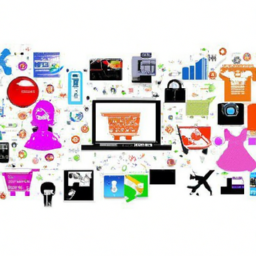Consumer Trends In India
India is a vibrant and ever-evolving market for consumer goods, and keeping up with the latest trends is crucial for businesses looking to succeed in this booming economy. From the rise of e-commerce and digital payments to the growing demand for sustainable products, this article explores some of the key consumer trends shaping the Indian market. Discover the changing preferences, behaviors, and expectations of Indian consumers in this fast-paced landscape and gain valuable insights to stay ahead of the competition.
Table of Contents
E-commerce
E-commerce has witnessed a remarkable rise in recent years, with more and more people turning to online platforms for their shopping needs. The convenience and ease of browsing through a wide range of products from the comfort of your own home have made online shopping increasingly popular. Gone are the days when you had to visit multiple brick-and-mortar stores to find the perfect item; now, a few clicks and you can have it delivered to your doorstep. From electronics to clothing, groceries to furniture, there’s almost nothing you can’t buy online.
With the advent of smartphones and affordable internet plans, mobile shopping has gained tremendous popularity. The accessibility and convenience of shopping on mobile platforms have made it the go-to choice for many consumers. Whether it’s ordering groceries while commuting or browsing through fashion items during a lunch break, mobile shopping offers unparalleled convenience. E-commerce platforms have responded to this trend by improving their mobile apps and optimizing their websites for mobile browsing, making the shopping experience seamless and enjoyable.
Digital Payments
India experienced a significant revolutionary change in its payment landscape with the government’s demonetization move. The sudden withdrawal of high-value currency notes prompted a massive shift towards digital payments. People began exploring various digital payment options such as mobile wallets, UPI, and online banking to adapt to the new cashless economy. This shift not only eased the burden of carrying cash but also paved the way for a faster and more secure transaction process.
The growth of digital payment options has been remarkable. Today, consumers have an array of choices when it comes to payment methods. Mobile wallets, like Paytm and PhonePe, have gained significant traction with their user-friendly interfaces and cashback offers. The adoption of UPI, a government-backed payment interface, has further simplified the process, allowing seamless transactions across different banks and payment platforms.
Preference for Value and Discounts
The Indian consumer has become increasingly price-sensitive in recent years. With the rising cost of living and limited disposable income, consumers are constantly on the lookout for value-for-money products. The demand for affordable yet high-quality products has given rise to a couponing and discount culture. People are hunting for the best deals, comparing prices across different platforms, and using coupon codes to get additional discounts.
E-commerce platforms and brands have recognized this changing consumer behavior and have responded by offering attractive discounts and promotional offers. Flash sales, festive discounts, and loyalty programs are just some of the tactics used to attract price-conscious shoppers. The couponing and discount culture have become deeply ingrained in the Indian consumer psyche, influencing their purchasing decisions and encouraging them to seek out the best deals.
Shift Towards Health and Wellness
Indian consumers are becoming more aware of the importance of health and wellness in their lives. As lifestyles become increasingly hectic, people are prioritizing their well-being. The growing consciousness of health has led to a preference for organic and natural products. Consumers are looking for products that are free from harmful chemicals and artificial ingredients, opting instead for those that promote overall wellness.
This shift towards health and wellness has also fueled the rise of fitness and wellness apps. People are increasingly using these apps to track their physical activity, monitor their diets, and receive personalized recommendations for a healthier lifestyle. Additionally, there is a soaring demand for healthier food options. Consumers are actively seeking out organic and locally sourced food products, as well as exploring different dietary choices such as veganism and gluten-free diets.
Changing Food Consumption Patterns
In recent years, there has been a noticeable change in food consumption patterns among Indian consumers. The preference for ready-to-eat meals has seen a significant increase. Busy lifestyles and time constraints have led people to opt for convenient and hassle-free meal options. This has given rise to the popularity of food delivery services, which bring a variety of cuisines right to consumers’ doorsteps.
With the rise of food delivery platforms such as Swiggy and Zomato, consumers have access to a wide range of restaurants and cuisines. The demand for international cuisines has seen a significant surge, with consumers becoming more adventurous in their culinary choices. At the same time, there is also a growing preference for healthy snacks. Consumers are looking for options that not only satisfy their taste buds but also align with their health and wellness goals.
Rise of Local Brands
Indian consumers have shown a strong preference for indigenous products and locally made goods. There has been a conscious effort to support and promote traditional crafts and textiles, showcasing the rich cultural heritage of the country. This shift towards local brands can be attributed to a desire for unique and authentic products, as well as a sense of pride in Indian craftsmanship.
The promotion of traditional crafts and textiles has gained momentum through various initiatives, such as government schemes and exhibitions. Consumers are actively seeking out products that are not mass-produced, but rather handcrafted using traditional techniques. The rise of local brands and the emphasis on indigenous products have not only boosted the economy but also helped preserve traditional artisanal skills.
Shift in Fashion and Lifestyle Choices
As globalization continues to influence cultures around the world, Indian consumers have adopted western fashion trends. There has been a growing interest in sustainable fashion, with consumers looking for eco-friendly and ethically produced clothing. The rise of athleisure and casual wear has also seen a surge in popularity, as people prioritize comfort and versatility in their everyday clothing choices.
Alongside sustainable fashion, there is a preference for eco-friendly products in other areas as well. Consumers are increasingly conscious of the environmental impact of their purchasing decisions and are actively seeking out eco-friendly alternatives. This shift towards eco-friendly products extends beyond fashion to include personal care items, home goods, and even packaging materials.
Increasing Importance of Reviews and Recommendations
online reviews and ratings have become an integral part of the decision-making process for Indian consumers. With the abundance of information available on the internet, people rely heavily on the experiences and opinions of others when making purchasing decisions. Whether it’s checking product reviews on e-commerce platforms or seeking recommendations from friends on social media, consumer purchasing behavior is heavily influenced by online feedback.
Social media influencers also play a significant role in shaping consumer opinions and preferences. Influencers with a large following on platforms like Instagram and YouTube have the power to sway consumer choices through their endorsements and product recommendations. This has led to the emergence of influencer marketing as a powerful tool for brands to reach and engage with their target audience.
Word-of-mouth recommendations still hold sway in the Indian market. Consumers trust the opinions of their friends and family and are more likely to make a purchase based on a recommendation. In fact, many consumers actively seek out recommendations from their social circles before making a buying decision. The power of word-of-mouth marketing cannot be underestimated, as it builds trust and credibility among consumers.
Rapid Urbanization and Changing Consumer Behavior
India has witnessed rapid urbanization in recent years, leading to significant changes in consumer behavior. The shift from joint families to nuclear families has resulted in smaller households with different needs and priorities. Dual-income households have become more common, meaning both partners are contributing to the household income. This has resulted in a higher disposable income and increased purchasing power.
As urban lifestyles become more fast-paced and demanding, consumers are seeking convenience and time-saving products. Whether it’s ready-to-eat meals, online grocery delivery services, or smart home devices to automate daily tasks, consumers are looking for ways to simplify their lives. Brands that can cater to these needs and provide convenient solutions are likely to gain a competitive edge in the market.
Sustainable and Ethical Consumption
There has been a rise in conscious consumerism in India, with consumers prioritizing sustainable and ethical products. People are increasingly concerned about the environmental impact of their choices and are actively seeking out eco-friendly and cruelty-free alternatives. Brands that prioritize environmental sustainability and fair trade practices are gaining popularity among consumers.
The demand for eco-friendly products extends beyond fashion and personal care to encompass various industries. From household goods to food products to electronics, consumers are looking for options that align with their values and have a positive impact on the environment. The growth of sustainable and ethical consumption is a testament to the increasing awareness and consciousness among Indian consumers.
In conclusion, consumer trends in India are witnessing significant shifts influenced by factors such as the rise of e-commerce, the growth of digital payments, changing preferences for value and discounts, the focus on health and wellness, evolving food consumption patterns, the rise of local brands, changing fashion choices, the importance of reviews and recommendations, rapid urbanization, and the increasing emphasis on sustainable and ethical consumption. As consumer behavior continues to evolve, brands and businesses need to be aware of these trends and adapt their strategies to meet the changing needs and preferences of the Indian consumer.






